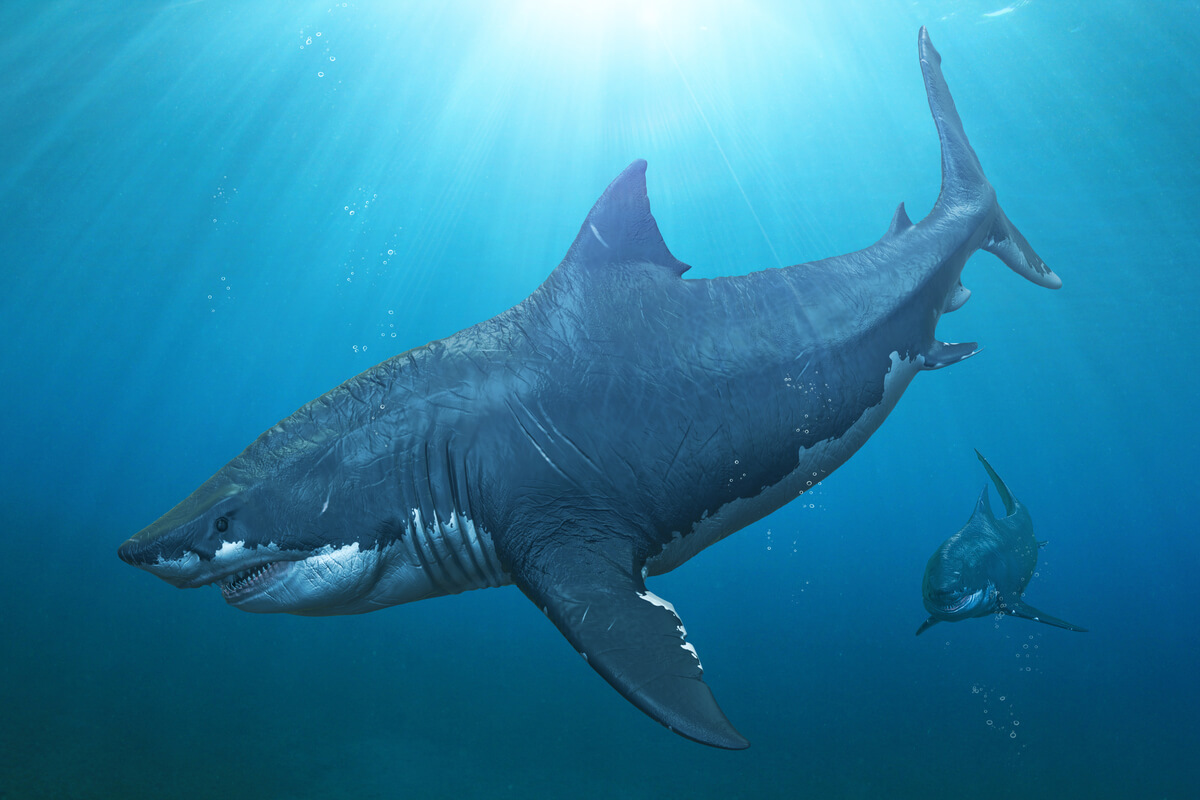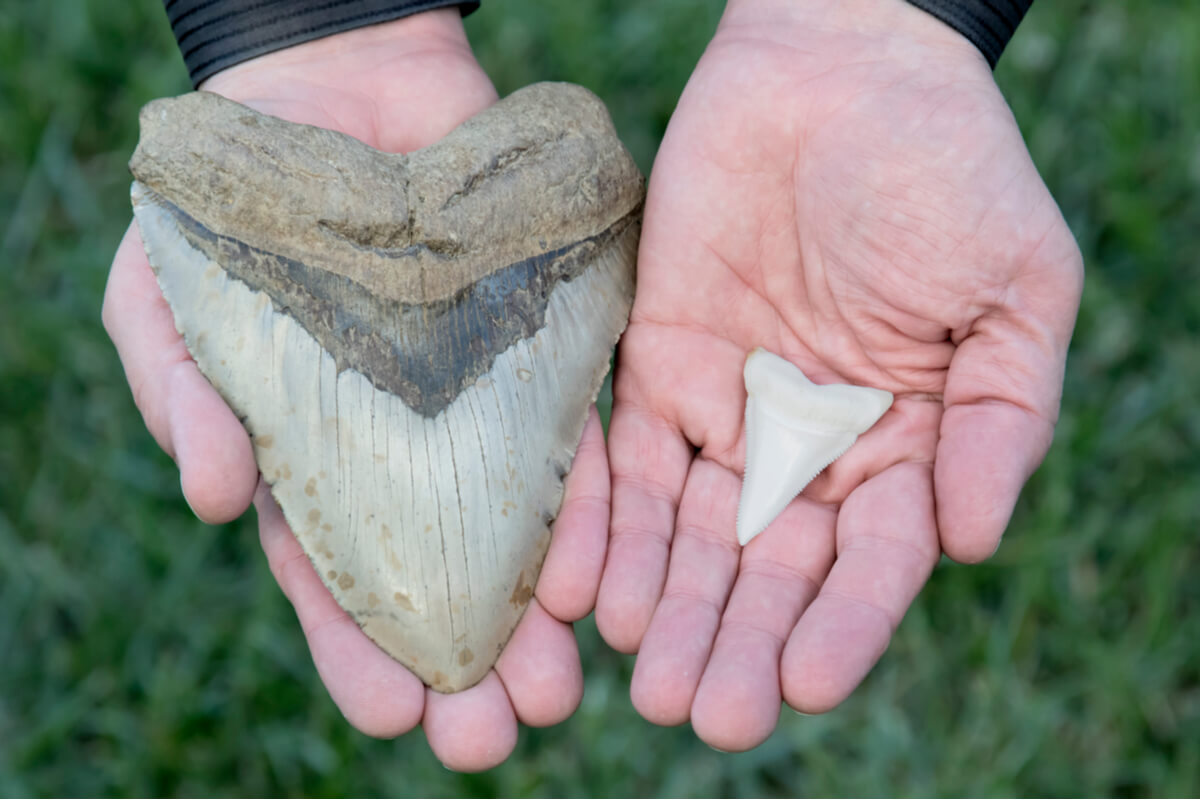Great White Sharks and Their Effect on Megalodon Extinction


Written and verified by the biologist Cesar Paul Gonzalez Gonzalez
The megalodon is one of the most powerful predators to have ever existed in Earth’s history. It lived from the Miocene to the Pliocene, which means that it appeared 18 million years ago and disappeared 3 million years ago. The reason for its disappearance isn’t yet known with certainty. However, it’s believed that competition between white sharks may provide one of the answers to megalodon extinction.
It was clear that the enormous size and ferocity of this chondrichthyan put it at the top of the food chain. But at the end of the Pliocene, severe land changes occurred that could have affected it. Read on to learn how white sharks could have caused the megalodon extinction.
What was the megalodon?
The megalodon (Otodus megalodon) was similar in appearance to today’s sharks, with the great difference that it reached gigantic sizes of 20 meters (65 feet) in length. It’s considered to have had one of the most lethal and strongest bites in the animal kingdom, exceeding by almost 10 times the munch of the great white shark and by 5 times a tyrannosaurus rex bite.
This species is described by using the remains of teeth and some vertebrae fossilized in nature. However, there’s no complete “skeleton” as such to visualize its enormous nature. Moreover, the size of its body is actually a prediction based on the huge teeth that have been found.
The megalodon’s habitat covered almost all the seas of its time, although it preferred temperate waters a bit more. In general, it’s considered to be a fairly mobile animal that lived in a wide range of ecosystems, as it constantly changed its location.
Despite its enormous size, the megalodon had an impressive swimming capacity and the instincts of a superpredator. Because of this, it could consume different types of prey, from cetaceans such as small whales, to sea turtles. Thanks to its powerful bite, no animal could defend or protect itself from its attack.

The megalodon extinction
The extinction of the megalodon still hasn’t been completely deciphered, as there are several situations and factors that could have caused it. In general, most experts point out that the disappearance of the species was due to a group of factors and not only to one in particular. Some of them are the following.
1. The closure of the Isthmus of Panama
The Isthmus of Panama is a geographical feature of the Americas that forms a kind of barrier between the Pacific Ocean and the Atlantic Ocean. This continental mass emerged from the ocean depths progressively since the Miocene. However, it didn’t close the contact between the two oceans until 3 million years ago.
The closure of the Isthmus of Panama caused the distribution of species to change, as well as preventing the passage of other animals such as the megalodon. Therefore, it’s likely that this event impacted the shark’s normal life and affected its adaptation.
2. Ocean cooling
The closure of the isthmus not only prevented the passage of species, but also modified the circulation of water and its dynamics. Consequently, in the northern hemisphere of the planet, a cooling of the oceans began to occur, which led to the expansion of glaciation.
Although the megalodon was able to withstand these changes in its habitat, its metabolism must have suffered some repercussions. Therefore, their hunting efficiency is likely to have gradually decreased.
3. Prey reduction
Another of the most important events during the Miocene was the great diversification of cetaceans. This group of animals was one of the strongest competitors of the megalodon, as their size and hunting abilities were also efficient. Of course, they weren’t the best in their habitat, but they reduced the available prey in the environment.
The big problem with this group is that their metabolism was better adapted to cold conditions, so they benefited from the recent change in ocean temperature. Consequently, the available prey became smaller as cetaceans became more relevant. Conversely, megalodon capabilities were restricted under these conditions.
4. Competition with other species
The change in ocean conditions brought about diversification and the emergence of new species. This meant that the megalodon habitat became crowded with new competitors looking for food. Therefore, resources became scarce and animals began to compete with each other for survival.
Competition is a negative interaction that expends unnecessary energy, so most species avoid it. However, the situation of the environment at that time meant that the megalodon had no alternative. Consequently, its adaptive capacity and hunting ability could have been greatly affected.
How did white sharks influence the extinction of the megalodon?
Like the megalodon, white sharks (Carcharodon carcharias) appeared during the Miocene. This implies that, at some point, they coexisted with what was one of the largest and strongest predators in the world. However, they co-existed without conflict for a long time thanks to the existence of sufficient prey in their habitat.
In 2022, a curious study was published in the journal Nature Communications which proposes that white sharks may have consumed the same food as the megalodon. This means that they competed at some point and that the winner was the white shark.

The study bases its assertions on the analysis of the abundance of certain zinc isotopes in their teeth. These elements can only be obtained through diet and their quantity varies according to the preferences of the species. In other words, if, at some point, two animals had the same amount, it would mean that they both consumed the same type of food.
When they performed the analysis on megalodon teeth and white shark teeth, they found that at a certain point in the Pliocene, the amount of zinc was the same. For this reason, it’s believed that both had a strong competitive struggle for resources, which could be one of the causes that led to megalodon extinction.
Despite the above, the extinction of the megalodon is still considered a multifactorial event, so the presence of white sharks is only one more cause of its disappearance. Nevertheless, it’s clear that the evolution of this white shark was a contributing factor in the fall of a great titan like the megalodon.
All cited sources were thoroughly reviewed by our team to ensure their quality, reliability, currency, and validity. The bibliography of this article was considered reliable and of academic or scientific accuracy.
- Boessenecker, R. W., Ehret, D. J., Long, D. J., Churchill, M., Martin, E., & Boessenecker, S. J. (2019). The Early Pliocene extinction of the mega-toothed shark Otodus megalodon: a view from the eastern North Pacific. PeerJ, 7, e6088.
- McCormack, J., Griffiths, M. L., Kim, S. L., Shimada, K., Karnes, M., Maisch, H., … & Tütken, T. (2022). Trophic position of Otodus megalodon and great white sharks through time revealed by zinc isotopes. Nature Communications, 13(1), 1-10.
- Pimiento, C., Ehret, D. J., MacFadden, B. J., & Hubbell, G. (2010). Ancient nursery area for the extinct giant shark Megalodon from the Miocene of Panama. PLoS one, 5(5), e10552.
- Wroe, S., Huber, D. R., Lowry, M., McHenry, C., Moreno, K., Clausen, P., … & Summers, A. P. (2008). Three‐dimensional computer analysis of white shark jaw mechanics: how hard can a great white bite?. Journal of Zoology, 276(4), 336-342.
- Caro, H. D. (1990). Estratigrafía, paleoceanografía y paleobiogeografía de la cuenca del Atrato y la evolución del Istmo de Panamá. Boletín Geológico, 31(1), 4-45.
This text is provided for informational purposes only and does not replace consultation with a professional. If in doubt, consult your specialist.